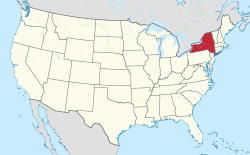Clarence, New York Tanumnogao (Wenrohronon) | |
|---|---|
 Clarence Hollow, the main district of Clarence | |
 Location in Erie County and the state of New York. | |
 Location of New York in the United States | |
| Coordinates: 42°58′36″N78°35′31″W / 42.97667°N 78.59194°W | |
| Country | |
| State | |
| County | Erie |
| Incorporated | 1808 |
| Founded by | Asa Ransom |
| Named after | Prince William, Duke of Clarence |
| Government | |
| • Type | Supervisor–council government |
| • Town Supervisor | Patrick Casilio (R) |
| • Town Council | |
| Area | |
• Total | 53.63 sq mi (138.90 km2) |
| • Land | 53.50 sq mi (138.56 km2) |
| • Water | 0.13 sq mi (0.34 km2) |
| Elevation | 735 ft (224 m) |
| Population (2020) | |
• Total | 32,950 |
| • Density | 604.3/sq mi (233.32/km2) |
| Time zone | UTC-5 (EST) |
| • Summer (DST) | UTC-4 (EDT) |
| ZIP Codes |
|
| Area code | 716 |
| FIPS code | 36-029-15825 |
| Website | www4 |
Clarence is a town and affluent suburb located in the northeastern part of Erie County, New York, United States, northeast of Buffalo. The population was 32,950 according to the 2020 census estimate. [2] This represents an increase of 7.4% from the 2010 census figure. [3] The Clarence census-designated place occupies the southeast part of the town and roughly corresponds to a postal district with ZIP code 14031 and 14221 in the western side which it shares with nearby Williamsville. The town is named in honor of Prince William, Duke of Clarence and St Andrews (1765–1837), the third son of King George III and later king himself, as William IV. [4]
Contents
- History
- Early history
- Later history
- Geography
- Nearby cities and towns
- Major highways
- Demographics
- Politics and government
- Politics
- Government
- Communities and locations
- Communities
- Physiographic locations
- Cultural institutions
- Education
- Notable residents
- Sister city
- References
- External links
There are no incorporated villages within the town.


